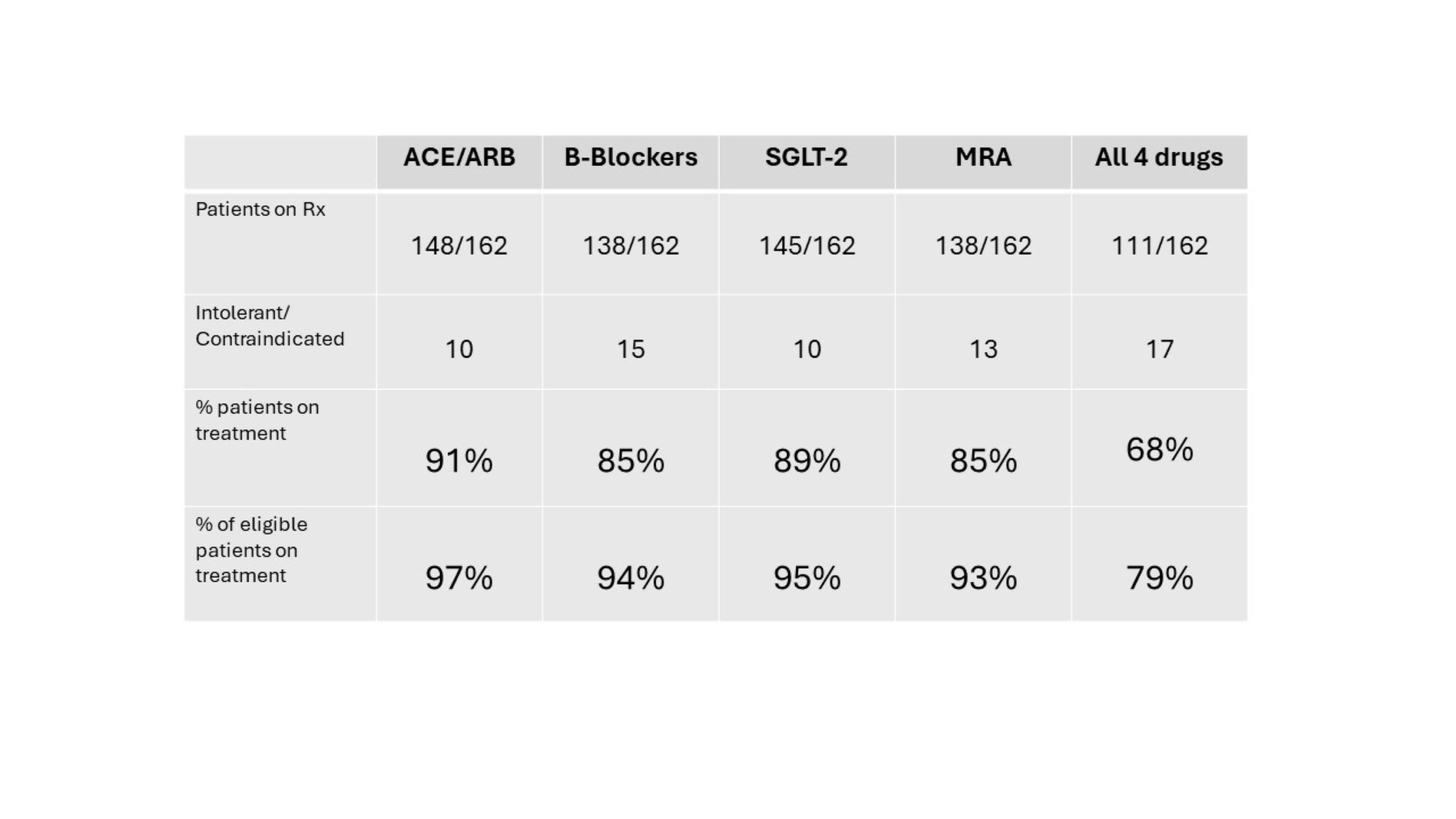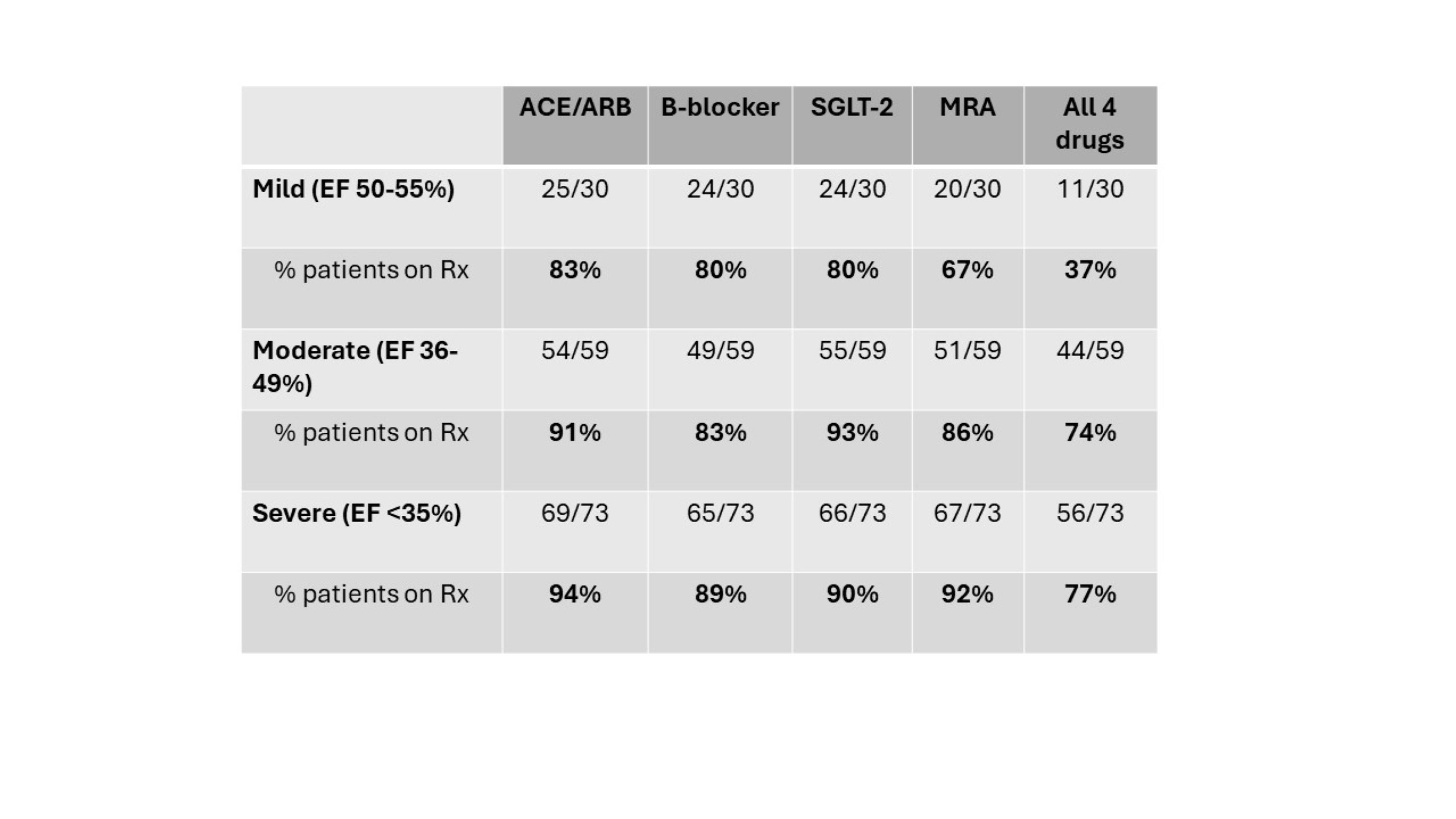Final ID: MDP1339
How succesfully can we presribe the 'four pillars' of medications for patients with heart failure with reduced LV systolic function?
Abstract Body (Do not enter title and authors here): Introduction
European, American and UK guidelines all endorse the prescription of the 'four pillars' of treatment (ACE/ARBs, b-blockers, MRAs and SGLT2 inhibitors) for heart failure with reduced LV systolic function (HFrEF). Many doctors believe that it is difficult to initiate and maintain patients on all these medications. We have studied 162 consecutive patients referred to our service as outpatients from primary care, subsequently diagnosed as having HFrEF, and our ability to establish them on these medications.
Methods
Patients referred with potential heart failure (signs, symptoms and raised BNP) were identified as having HFrEF by echocardiography using British Society of Echocardiography (BSE) criteria. Patients attended regular outpatient appointments with a consultant cardiologist and specialist heart failure nurse and were prescribed and uptitrated all appropriate medications with any contraindications and intolerances noted.
Results
Table 1 shows the number of patients sucessfully established on maximally tolerated doses of each class of medication. Reasons for not prescibing or discontinuing were: CKD 6, severe aortic stenosis 5, asthma 3, symptomatic bradycardia 5, hypotension 3, type1 diabetes 2, syncope 1, Raynauds 1, patient choice 8 and 6 patients died before all appropriate medications could be initiated. In 10 cases no clinical reason could be identified.
It can be seen that a high proportion of patients were successfully established on each individual class of medication and more than two thirds of patients were able to be maintained on all four classes of therapy.
Table 2 shows the breakdown of prescribing success according to the severity of LV dysfunction. It can be seen that prescribing success appears to be higher in those with the more severe LV dysfunction.
Conclusions
1. The majority of patients can be established and maintained on appropriate polypharmacy for the treatment of LV systolic dysfunction.
2. The severity of LV systolic dysfunction is not a negative predictor of success in prescribing.
European, American and UK guidelines all endorse the prescription of the 'four pillars' of treatment (ACE/ARBs, b-blockers, MRAs and SGLT2 inhibitors) for heart failure with reduced LV systolic function (HFrEF). Many doctors believe that it is difficult to initiate and maintain patients on all these medications. We have studied 162 consecutive patients referred to our service as outpatients from primary care, subsequently diagnosed as having HFrEF, and our ability to establish them on these medications.
Methods
Patients referred with potential heart failure (signs, symptoms and raised BNP) were identified as having HFrEF by echocardiography using British Society of Echocardiography (BSE) criteria. Patients attended regular outpatient appointments with a consultant cardiologist and specialist heart failure nurse and were prescribed and uptitrated all appropriate medications with any contraindications and intolerances noted.
Results
Table 1 shows the number of patients sucessfully established on maximally tolerated doses of each class of medication. Reasons for not prescibing or discontinuing were: CKD 6, severe aortic stenosis 5, asthma 3, symptomatic bradycardia 5, hypotension 3, type1 diabetes 2, syncope 1, Raynauds 1, patient choice 8 and 6 patients died before all appropriate medications could be initiated. In 10 cases no clinical reason could be identified.
It can be seen that a high proportion of patients were successfully established on each individual class of medication and more than two thirds of patients were able to be maintained on all four classes of therapy.
Table 2 shows the breakdown of prescribing success according to the severity of LV dysfunction. It can be seen that prescribing success appears to be higher in those with the more severe LV dysfunction.
Conclusions
1. The majority of patients can be established and maintained on appropriate polypharmacy for the treatment of LV systolic dysfunction.
2. The severity of LV systolic dysfunction is not a negative predictor of success in prescribing.
More abstracts on this topic:
9-Year Longitudinal Assessment of the 12-lead Electrocardiogram of Volunteer Firefighters
Bae Alexander, Dzikowicz Dillon, Lai Chi-ju, Brunner Wendy, Krupa Nicole, Carey Mary, Tam Wai Cheong, Yu Yichen
Association of NSAIDs Use, Pain Interference, and Incident Heart Failure among REGARDS Participants with Diabetes.Khodneva Yulia, Soroka Orysya, Goyal Parag, Cherrington Andrea, Reid Ro-jay, Nordberg Megan, Safford Monika, Levitan Emily


